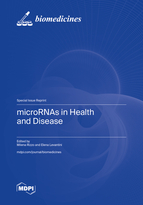microRNAs in Health and Disease
A special issue of Biomedicines (ISSN 2227-9059). This special issue belongs to the section "Cell Biology and Pathology".
Deadline for manuscript submissions: closed (15 May 2023) | Viewed by 35235
Special Issue Editors
Interests: miRNAs; non-coding RNAs; gene expression regulation; transcriptomics; cancer biology; prostate cancer; drug resistance; cancer therapy; RNA therapy; circulating miRNAs
Interests: miRNAs; non-coding RNAs; NSCLC; murine models; therapeutic targeting; drug resistance mechanisms; cancer stem cells; single cell transcriptomics; transcription factors; KRAS; EGFR; BMI1
Special Issues, Collections and Topics in MDPI journals
Special Issue Information
Dear Colleagues,
microRNAs (miRNAs) are small non-coding RNAs and key gene expression regulators at the post-transcriptional level. miRNA-dependent gene expression regulation is fundamental in almost all biological processes. As a consequence, its dysregulation plays a relevant role in the onset and progression of several diseases. Consistently, knowledge of the complex regulatory networks established by miRNAs together with mRNAs and the different non-coding RNAs classes (e.g., linear long non-coding RNAs and circular RNAs) may represent a huge source of therapeutic targets.
The aim of this Special Issue is to collect original research papers, reviews and commentaries focused on the recent advances in the field of miRNAs in both health and disease. Of special interest are new insights into miRNAs mechanisms of action underlying physiological and pathological processes and diseases, miRNA-associated therapeutic target discovery, miRNA-associated RNA-based therapy (including miRNAs delivery systems), miRNA biomarkers (including circulating miRNAs) and miRNAs in cell-to-cell communication.
Dr. Milena Rizzo
Dr. Elena Levantini
Guest Editors
Manuscript Submission Information
Manuscripts should be submitted online at www.mdpi.com by registering and logging in to this website. Once you are registered, click here to go to the submission form. Manuscripts can be submitted until the deadline. All submissions that pass pre-check are peer-reviewed. Accepted papers will be published continuously in the journal (as soon as accepted) and will be listed together on the special issue website. Research articles, review articles as well as short communications are invited. For planned papers, a title and short abstract (about 100 words) can be sent to the Editorial Office for announcement on this website.
Submitted manuscripts should not have been published previously, nor be under consideration for publication elsewhere (except conference proceedings papers). All manuscripts are thoroughly refereed through a single-blind peer-review process. A guide for authors and other relevant information for submission of manuscripts is available on the Instructions for Authors page. Biomedicines is an international peer-reviewed open access monthly journal published by MDPI.
Please visit the Instructions for Authors page before submitting a manuscript. The Article Processing Charge (APC) for publication in this open access journal is 2600 CHF (Swiss Francs). Submitted papers should be well formatted and use good English. Authors may use MDPI's English editing service prior to publication or during author revisions.








